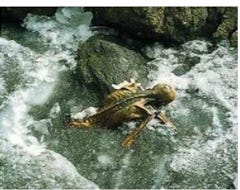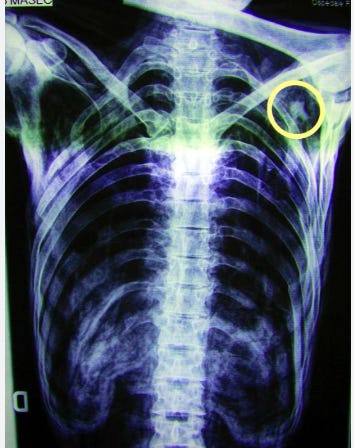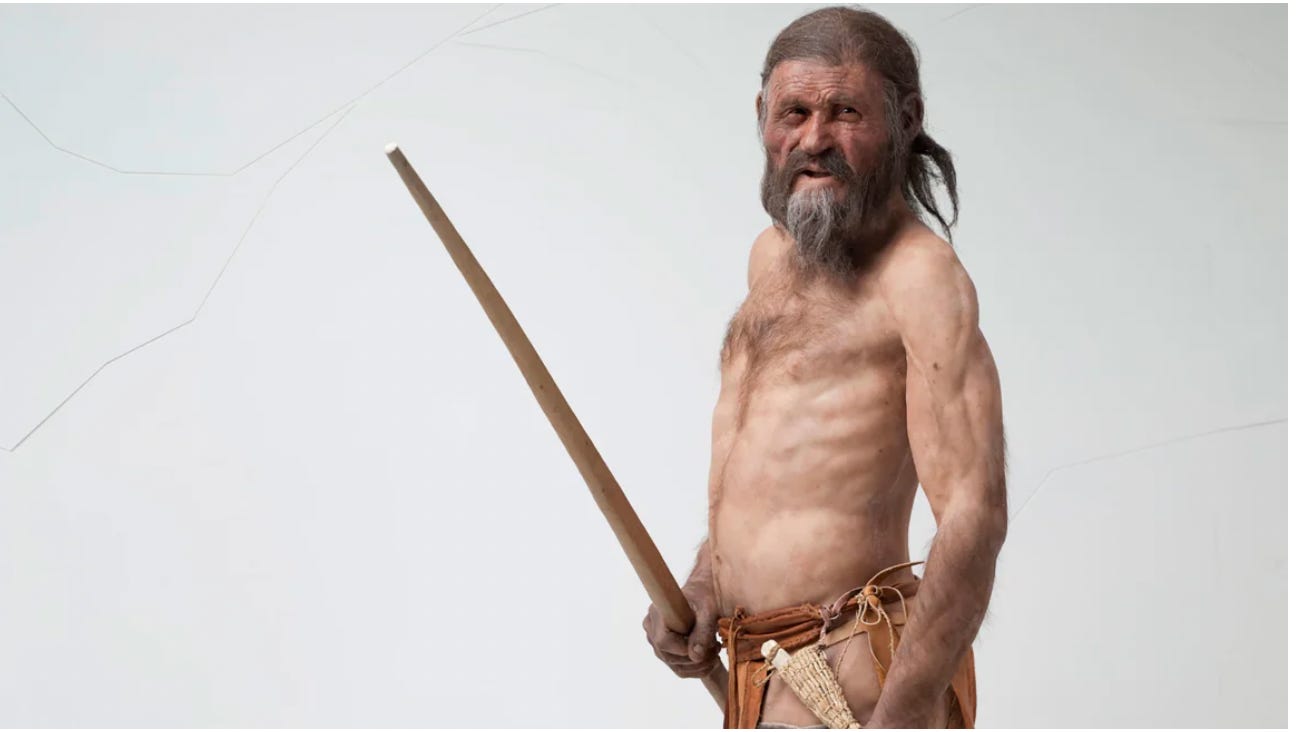Is the Human Mind Still in the Copper Age?
In our basic instincts and emotions, we are probably not so different from Oetzi the Iceman was 5,200 years ago.
On Thursday, September 19, 1991, Erika and Helmut Simon, a couple from Nuremberg, climbed the Fineilspitze, a mountain lying about fifty kilometers southwest of Innsbruck. On their way down from the summit, they took a route just below a ridge called the Hauslabjoch, which had long been used as a pass over the main ridge of the Alps. Traversing a glacier called the Niederjochferner, they approached a narrow gully and saw a brown figure sticking out of the ice.
Upon closer inspection they saw it was a human. Only his head, shoulders, and upper back were exposed; the rest of him was still encased in ice. The Simons photographed the corpse with their last frame of film, and then descended to the Similaun Hut to report their discovery. The hut manager called the gendarmerie in the town of Soelden, whose inspector first thought the corpse to be a music professor from Verona named Carlo Capsoni who’d vanished in the area in 1941 (the inspector later learned that Capsoni’s body had been recovered in the fifties). Innsbruck prosecutor Robert Wallner was notified, and he opened an investigation into the possibility of foul play, offender unknown.
Because bad weather made landing a helicopter at the site unsafe, the air rescue service and Professor Rainer Henn from the Innsbruck Institute of Forensic Medicine were unable to recover the body for a few days. In the meantime, several hikers visited the site, and they noticed strange fragments of birch bark, wood, and fur that had apparently comprised the dead alpinist’s equipment.
Most remarkable was a tool with a long wooden handle on which a metal blade was fixed with leather thongs. It appeared to be some kind of ice axe, but certainly not a modern one. Upon hearing a description of the tool, the famous climber Reinhold Messner, who later visited the site, said he reckoned it had to be at least five hundred years old. Shortly thereafter the local press printed rumors that the dead man had been a mercenary in the employ of Frederick Empty Purse, a fifteenth century Tyrolean count.
On Monday, September 23, the body was freed from the ice and flown to the Innsbruck Institute of Forensic Medicine. The forensic doctor Hans Unterdorfer began with an external inspection, from which he concluded that the body was at least several hundred years old and bore no signs of fatal or even severe injuries. Most of the damage was superficial, probably from scavenging animals. The left thigh and pelvic region were damaged, apparently from a dog-like scavenger (in fact from a pneumatic chisel during recovery, as was later determined). Dr. Unterdorfer found nothing suspicious about the condition of the body, and concluded the ancient man must have been caught at high altitude by an unexpected blizzard and died of hypothermia.
The next day, a University of Innsbruck archeologist named Konrad Spindler examined the artifacts found with the body and concluded they were at least four thousand years old. Subsequent radiocarbon dating determined that the man had died around 3300 B.C. His pure copper axe dated him from the Copper Age—a transitional period between the Neolithic and Bronze Ages.
Ten years later, a CT scan of Oetzi’s body revealed an arrow head lodged in his left shoulder. Someone had shot him in the back, causing a fatal wound that wasn’t noticed during the initial examination in Innsbruck. Not hypothermia, but a murderer had killed the Ice Man.
Examinations of the 5,200-year old ice mummy have revealed many fascinating details. An interest in symbols and decorations is evidenced by his 61 tattoos — black lines and crosses on his left wrist, lower legs, lower back and chest. Found with his body were the following items:
Copper Axe: A fully equipped axe with a copper blade and an yew wood handle.
Flint Dagger: A small dagger with a chert blade and an ash wood handle, likely used for cutting and various tasks.
Arrows and Quiver: Ötzi carried a quiver containing 14 arrows, with two finished and broken, and 12 unfinished arrows.
Bow: An unfinished bow made of yew, demonstrating that Ötzi was likely in the process of crafting a new one.
Leather Pouch: A pouch containing various small tools including flint pieces, a scraper, a drill, a bone awl, and a fire-starting kit, and the following medicinal plants and fungi.
Birch polypore: This fungus was found attached to leather straps in Ötzi's kit. It's known to have anti-inflammatory and antibiotic properties, and it's also toxic to whipworms, a parasite found in Ötzi's intestines.
Sloe berries: These berries, also part of his kit, are known for their astringent and medicinal properties, though their exact use by Ötzi is unknown.
Bracken fern: This fern was found in Ötzi's stomach. It's possible he ate it as a primitive food wrapper, but it could also have been used to treat intestinal parasites.
Bog moss: Traces of bog moss were found on Ötzi, possibly used as makeshift bandages
Other Items: A birch bark container, possibly for carrying embers, a net for catching small game, and a game noose.
I suspect that Oetzi and the archer who killed him were pretty much just like us in their basic instincts and emotions. Observing my fellow man today, I perceive our species to be highly atavistic—that is, aggressive, tribalistic, and quarrelsome.
What do you think?







I think he was more informed about personal health and healing and knew nature was where true health care is found. More in harmony with the natural world and capable of self-care without having to go see an "expert" hoping it's not one of the 95% who don't know what they're doing and more like the 5% (Dr McCullough) who do.
Ecclesiastes 1:9
That which has been is that which will be,
And that which has been done is that which will be done.
So there is nothing new under the sun.